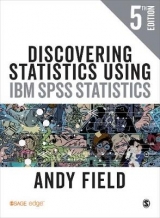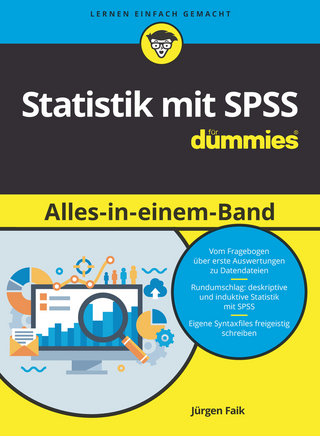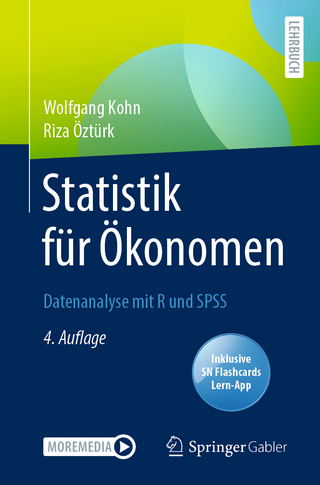
Discovering Statistics Using IBM SPSS Statistics
SAGE Publications Ltd (Verlag)
978-1-4462-4918-5 (ISBN)
- Titel erscheint in neuer Auflage
- Artikel merken
With a little help from his weird band of characters the Fourth Edition of the award-winning book continues, with its unique blend of humour and collection of bizarre examples, to bring statistics - from first principles to advanced concepts - well and truly to life using IBM SPSS Statistics.
Lecturers: with WebAssign® you can manage and monitor your students′ progress quickly and easily online or give them more opportunities to practise!
Ideal for short courses, choose to use WebAssign® alongside the Fourth Edition of Andy Field′s textbook to quickly set up courses and schedule assignments (using the 2159 questions available) and track individual performance so you can spot in an instant where more instruction or practice is needed. If not using for fomal assessment, WebAssign® still lets you set questions for your students to practise over and over again. They get instant feedback and also links to the relevant chapter or section in the integral ebook to help them work out the correct solution.
Students please note: access to WebAssign® is dependent not only on the purchase of a student access code (ISBN: 9781446273043) but also a username, institution code and password supplied by your course leader/instructor.
SAGE MobileStudy - study where and when you like
Scan any QR code within the book to access revision material on a smartphone or tablet such as Cramming Sam′s Study tips, flashcard glossaries, interactive multiple choice questionnaires and more.
Support materials for a wide range of disciplines
Education and Sport Sciences lecturer support materials with enhanced ones for Psychology, Business and Management and the Health Sciences on the enhanced Companion Website make the book even more relevant to a wider range of subjects across the social sciences and where statistics is taught to a cross-disciplinary audience.
Other major new updates include:
Now fully compatible with recent IBM SPSS Statistics releases.
Two new characters! Statistical cult leader Oditi provides students with access to video clips via his Lantern to help further understanding of statistical/SPSS concepts, while Confusius helps students to make better sense of statistical terms.
The enhanced Companion Website offers plenty of lecturer and student material to use in conjunction with the textbook. These include PowerPoints and subject-specific testbanks for lecturers as well as answers to the Smart Alex tasks at the end of the each chapter; datafiles for testing problems in SPSS; flashcards of key concepts; self-assessment multiple-choice questions; and online videos of key statistical and SPSS procedures discussed in the textbook for students.
Andy Field is Professor of Quantitative Methods at the University of Sussex. He has published widely (100+ research papers, 29 book chapters, and 17 books in various editions) in the areas of child anxiety and psychological methods and statistics. His current research interests focus on barriers to learning mathematics and statistics. He is internationally known as a statistics educator. He has written several widely used statistics textbooks including Discovering Statistics Using IBM SPSS Statistics (winner of the 2007 British Psychological Society book award), Discovering Statistics Using R, and An Adventure in Statistics (shortlisted for the British Psychological Society book award, 2017; British Book Design and Production Awards, primary, secondary and tertiary education category, 2016; and the Association of Learned & Professional Society Publishers Award for innovation in publishing, 2016), which teaches statistics through a fictional narrative and uses graphic novel elements. He has also written the adventr and discovr packages for the statistics software R that teach statistics and R through interactive tutorials. His uncontrollable enthusiasm for teaching statistics to psychologists has led to teaching awards from the University of Sussex (2001, 2015, 2016, 2018, 2019), the British Psychological Society (2006) and a prestigious UK National Teaching fellowship (2010). He′s done the usual academic things: had grants, been on editorial boards, done lots of admin/service but he finds it tedious trying to remember this stuff. None of them matter anyway because in the unlikely event that you′ve ever heard of him it′ll be as the ′Stats book guy′. In his spare time, he plays the drums very noisily in a heavy metal band, and walks his cocker spaniel, both of which he finds therapeutic.
Why Is My Evil Lecturer Forcing Me to Learn Statistics?
What Will This Chapter Tell Me?
What The Hell Am I Doing Here? I Don′t Belong Here
Initial Observation: Finding Something That Needs Explaining
Generating Theories And Testing Them
Collect Data to Test Your Theory
Analyzing Data
Reporting Data
Everything You Never Wanted to Know about Statistics
What Will This Chapter Tell Me?
Building Statistical Models
Populations And Samples
Statistical Models
Going Beyond The Data
Using Statistical Models To Test Research Questions
Modern Approaches toTheory Testing
Reporting Statistical Models
The IBM SPSS Statistics Environment
What Will This Chapter Tell Me?
Versions Of IBM SPSS Statistics
Windows versus MacOS
Getting Started
The Data Editor
Importing Data
The SPSS Viewer
Exporting SPSS Output
The Syntax Editor
Saving Files
Retrieving A File
Exploring Data with Graphs
What Will This Chapter Tell Me?
The Art Of Presenting Data
The SPSS Chart Builder
Histograms
Boxplots (Box-Whisker Diagrams)
Graphing Means: Bar Charts And Error Bars
Line Charts
Graphing Relationships: The Scatterplot
Editing Graphs
The Best of Bias
What Will This Chapter Tell Me?
What is Bias?
Spotting Bias
Reducing Bias
Non-parametric Models
What Will This Chapter Tell Me?
When to Use Non-parametric Tests
General Procedure on Non-parametric Tests in SPSS
Comparing Teo Independent Conditions: The Wilcox Rank-sum Test and Mann-Whitney Test
Comparing Two Related Conditions: the Wilcoxon Signed-rank Test
Differences Between Several Independent Groups: The Kruskal-Wallis Test
Differences Between Several Related Groups: Friedman′s ANOVA
Correlation
What Will This Chapter Tell Me?
Modelling Relationships
Data Entry For Correlation Analysis Using SPSS
Bivariate Correlation
Partial Correlation
Comparing Correlations
Calculating The Effect Size
How To Report Correlation Coefficents
Regression
What Will This Chapter Tell Me?
An Introduction To Regression
Bias in Regression Models?
Regression Using SPSS: One Predictor
Multiple Regression
Regression With Several Predictors Using SPSS
Interpreting Multiple Regression
Comparing Two Means
What Will This Chapter Tell Me?
Looking at Differences
The t-test
Assumptions of the t-test
The Independent t-test Using SPSS
Paired-samples t-test Using SPSS
Between Groups or Repeated Measures
What is I Violate the Test Assumptions
Moderation, Mediation and More Regression
What Will This Chapter Tell Me?
Installing Custom Dialog Boxes in SPSS
Moderation: Interactions in Regression
Mediation
Categorical Predictors in Regression
Comparing Several Means: ANOVA (GLM 1)
What Will This Chapter Tell Me?
The Theory Behind Anova
Assumptions of Anova
Planned Contrasts
Post hoc Procedures
Running One-way Anova in SPSS
Output From One-way Anova
Calculating the Effect Size
Reporting Results From One-way Independent Anova
Analysis of Covariance, ANCOVA (GLM 2)
What Will This Chapter Tell Me?
What Is ANCOVA?
Assumptions And Issues In ANCOVA
Conducting ANCOVA in SPSS
Interpreting the Output From ANCOVA
Testing The Assumption Of Homogeneity Of Regression Slopes
Calculating The Effect Size
Reporting Results
Factorial ANOVA (GLM 3)
What Will This Chapter Tell Me?
Theory Of Factorial ANOVA (Independent Designs)
Assumptions of Factorial ANOVA
Factorial ANOVA using SPSS
Output From Factorial ANOVA
Interpreting Interaction Graphs
Calculating Effect Sizes
Reporting The Results Of Two-Way ANOVA
Repeated-Measures Designs (GLM 4)
What Will This Chapter Tell Me?
Introduction To Repeated Measures Designs
Theory Of One-Way Repeated-Measures ANOVA
Assumptions in Repeated-Measures ANOVA
One-Way Repeated Measures ANOVA Using SPSS
Output For One-Way Repeated-Measures ANOVA
Effect Sizes For Repeated-Measures ANOVA
Reporting One-Way Repeated-Measures ANOVA
Factorial Repeated-Measures Designs
Output For Factorial Repeated-Measures ANOVA
Effect Sizes For Factorial Repeated-Measures ANOVA
Reporting The Results From Factorial Repeated-Measures ANOVA
Mixed Design ANOVA (GLM 5)
What Will This Chapter Tell Me?
Mixed Designs
Assumptions in Mixed Designs
What Do Men And Women Look For In A Partner?
Mixed ANOVA in SPSS
Output For Mixed Factorial ANOVA
Calculating Effect Sizes
Reporting The Results Of Mixed ANOVA
Multivariate Analysis of Variance (MANOVA)
What Will This Chapter Tell Me?
When To Use MANOVA
Introduction
Theory Of MANOVA
Practical Issues When Conducting MANOVA
MANOVA Using SPSS
Output From MANOVA
Reporting Results From MANOVA
Following Up MANOVA With Discriminant Analysis
Output From The Discriminant Analysis
Reporting Results From from Discriminant Analysis
The Final Interpretation
Exploratory Factor Analysis
What Will This Chapter Tell Me?
When To Use Factor Analysis
Factors and Components
Discovering Factors
Research Example
Running The Analysis
Interpreting Output From SPSS
How To Report Factor Analysis
Reliability Analysis
How To Report Reliability Analysis
Categorical Data
What Will This Chapter Tell Me?
Analysing Categorical Data
Theory Of Analysing Categorical Data
Assumptions When Analysing Categorical Data
Doing Chi-Square in SPSS
Log-Linear Analysis Using SPSS
Effect Sizes In Loglinear Analysis
Reporting The Results Of Loglinear Analysis
Logistic Regression
What Will This Chapter Tell Me?
Background to Logistic Regression
What are the Principles Behind Logistic Regression?
Sources of Bias and Common Problems
Binary Logistic Regression: An Example That Will Make You Feel Eel
Interpreting Logistic Regression
How to Report Logistic Regression
Testing Assumptions: Another Example
Predicting Several Categories: Multinominal Logistic Regression
Multilevel Linear Models
What Will This Chapter Tell Me?
Hierarchical Data
Theory Of Multilevel Linear Models
The Multilevel Model
Some Practical Issues
Multilevel Modelling Using SPSS
Growth Models
How To Report A Multilevel Model
A Message From The Octopus of Inescapable Despair
Epilogue
Nice Emails
Everybody Thinks I′m A Statistician
Craziness on a Grand Scale
| Erscheint lt. Verlag | 31.3.2013 |
|---|---|
| Verlagsort | London |
| Sprache | englisch |
| Maße | 195 x 265 mm |
| Gewicht | 2000 g |
| Themenwelt | Geisteswissenschaften ► Psychologie |
| Mathematik / Informatik ► Mathematik ► Computerprogramme / Computeralgebra | |
| Sozialwissenschaften ► Soziologie ► Empirische Sozialforschung | |
| ISBN-10 | 1-4462-4918-2 / 1446249182 |
| ISBN-13 | 978-1-4462-4918-5 / 9781446249185 |
| Zustand | Neuware |
| Informationen gemäß Produktsicherheitsverordnung (GPSR) | |
| Haben Sie eine Frage zum Produkt? |
aus dem Bereich



